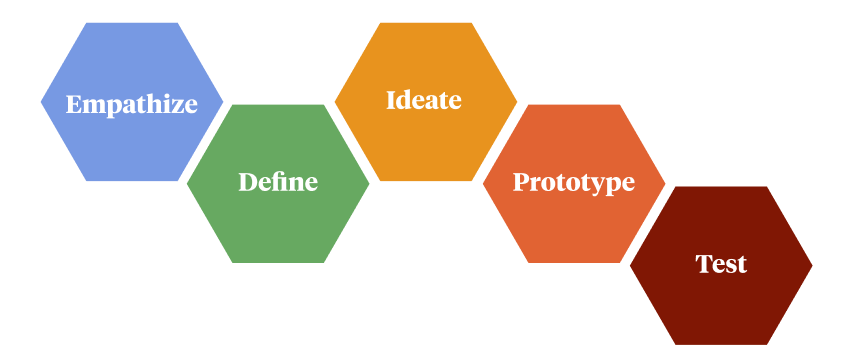
Design thinking is a human-centered approach to innovation that draws from the designer’s toolkit to integrate the needs of people, the possibilities of technology, and the requirements for business success. - Tim Brown: IDEO
Design Thinking is an approach we use at Ballast Lane to make sure we are building the right products for the right people. Many companies and startups fail simply because what they are selling does not address the needs of people, not enough value is being created. Design Thinking is an approach that any size company can use to create better products with these five steps: Empathy, Define, Ideate, Prototype, and Test. These can be used linearly or modified based on a team’s specific needs.

1. Empathize
The foundation of Design Thinking is empathy. The goal is to discover the insights and unmet needs of the people we want to serve. Taking a beginner’s point of view (POV) and immersing ourselves into people’s experiences helps us accomplish this.
Tips:
- Using a beginner’s “mindset” and immersing yourself in the user’s experience is a great way to uncover deep needs and insights
Insights uncovered at Ballast Lane:
- IoT: Movements such as the “Quantified Self” and apps like “Home” on iOS have changed our perceptions of what we can measure and control using our mobile phone. These expectations have worked their way into the enterprises and buildings we work in.
- Finance: Although there is a suite of digital tools that enable families to manage their financial lives, there is a lack of tools that help families with a certain level of wealth to effectively manage their increasingly complex finances.
- Moving: Although there is a shift in moving services becoming more digital, there is a lack of on-demand moving services designed for the mobile-first on-demand needs of many consumers.
- Research: The ubiquitous and adoption of touch screen devices has opened a new opportunity for researchers to present and gather data from children.
The older you get as a designer, the more you realize that you just don’t know anything … if you can embrace that you don’t know, but you know how to go find out, that makes you very effective. - Daniel Burka: Google Ventures
2. Define
With empathy as our foundation, we then define the problem by writing a POV that includes Who, What, and Why. Who we are designing for, What is their unmet need, and Why the info that has been gathered is insightful. The more specific details, the better. Reframing the problem / POV can often lead us to more innovative solutions.
Insights uncovered at Ballast Lane:
- Who is your user?
- What is their deep, unmet need?
- Why is this insightful?
POV Checklist.
- Provide focus and frame the problem
- Provide a reference for evaluating competing ideas
- Fuel brainstorms by suggesting “how might we” statements
- Save you from the impossible task of developing solution concepts that are all things to all people
- Allow you to revisit and reformulate the POV as you learn by doing
- Guide your innovation efforts
Examples:
- David is a building manager for 3 skyscrapers in NYC where one of his key responsibilities is managing the operating expenses associated with each building. He needs an easy way to understand what can be done to reduce energy consumption, and have visibility into actions taken and corresponding results.
- Nate is a LA resident who manages most of his life using his phone. When he needs to move large items he purchases for his house, he wants to be able to order moving services as easily as he can order an Uber.
- Ragan is a researcher at a leading University who wants to gather data about financial related questions from children in a way that is simple for her and engaging for the children.
3. Ideate
Now that the problem and POV have been narrowed down, we expand by brainstorming as many solutions as possible. The more ideas the better. Anything goes 😉
Two main rules for a successful brainstorm:
- Defer judgment
- Reach for quantity
Example Ideas from Brainstorm Sessions at Ballast Lane:
- The “Quantified Building”
- Uber for moving
- Moving concierge for online businesses
- Mint.com for your Family Office
- Mobile games meet Mobile Research
4. Prototype
At this stage, we narrow our focus again by creating a prototype of our best solution. The prototype serves as the foundation for what we will test with real people. The goal is to design and build just enough to be able to test, and nothing more. A good prototype helps answer the questions you and your team have, and validate the hypothesis.
Tips:
- “Wizard of Oz prototyping” “Build a prototype faster by using humans on the back-end to save time and resources.” "If you’re building a chat-bot, for example, have a human on the other end supplying the replies until you better understand the needs of the user”
Prototype as if you know you’re right, but test as if you know you’re wrong. - Stanford’s d.school
5. Test
Using the prototype, we can then test with the people we’ve been designing for. We are able to test our hypothesis, refine our POV, and continue to better understand the needs of our people.
Tips:
- Test early, test often
- Use a screener to weed out bad participants
- Family, friends, and social media are your friend when recruiting users
- Services like ethn.io and UserTesting can provide you with users in fairly targeted demographics.
Embracing Design Thinking enables us to make sure we are building the right products for the right people. The better we can understand people, what motivates them, and how they use technology, the better we can design a solution that truly helps. Whether at the beginning of a project or further into a product’s life-cycle, the various steps of Design Thinking can be used to make sure we stay focused on the people we are designing for.
More Reading: Design Thinking Handbook
